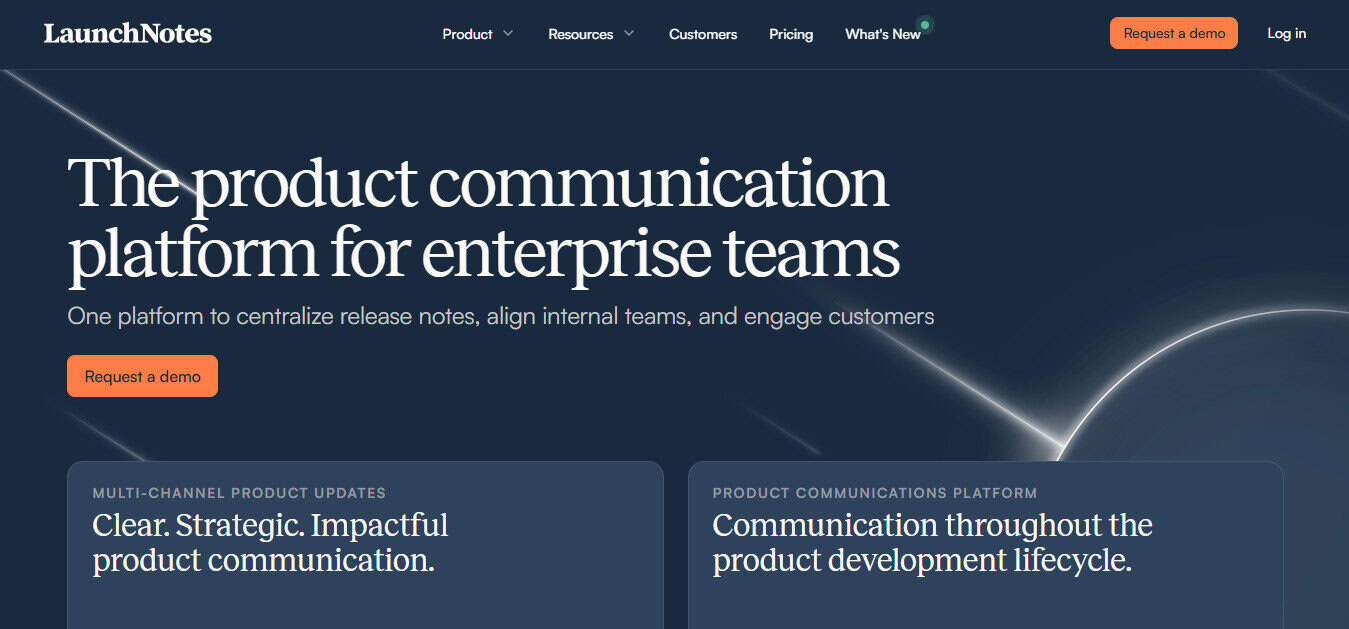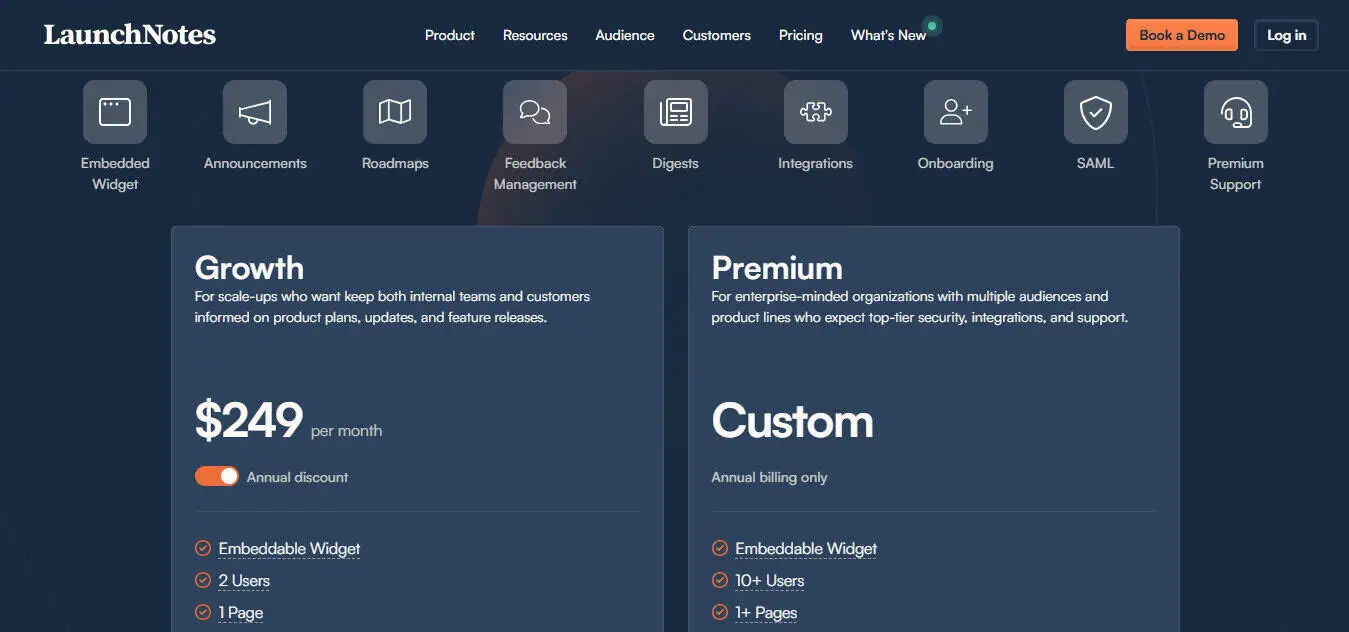Last Updated on October 3, 2025 by Ewen Finser
How’s your product roadmap looking these days? Is it helping your team stay on track, or is it starting to feel off? Maybe it’s time to see if there’s a better way to manage things. Perhaps it’s even time to try out a roadmapping tool!
Why use a roadmapping tool, and when does it become one of your daily tools?
The right tool can make a huge difference. It keeps your planning organized and makes it much easier to communicate your goals. Not only does your team stay aligned, but your customers also get a clear picture of where your product is headed. Everyone stays in the loop, which helps keep the entire product moving forward smoothly.
ProductBoard as a Roadmapping Tool
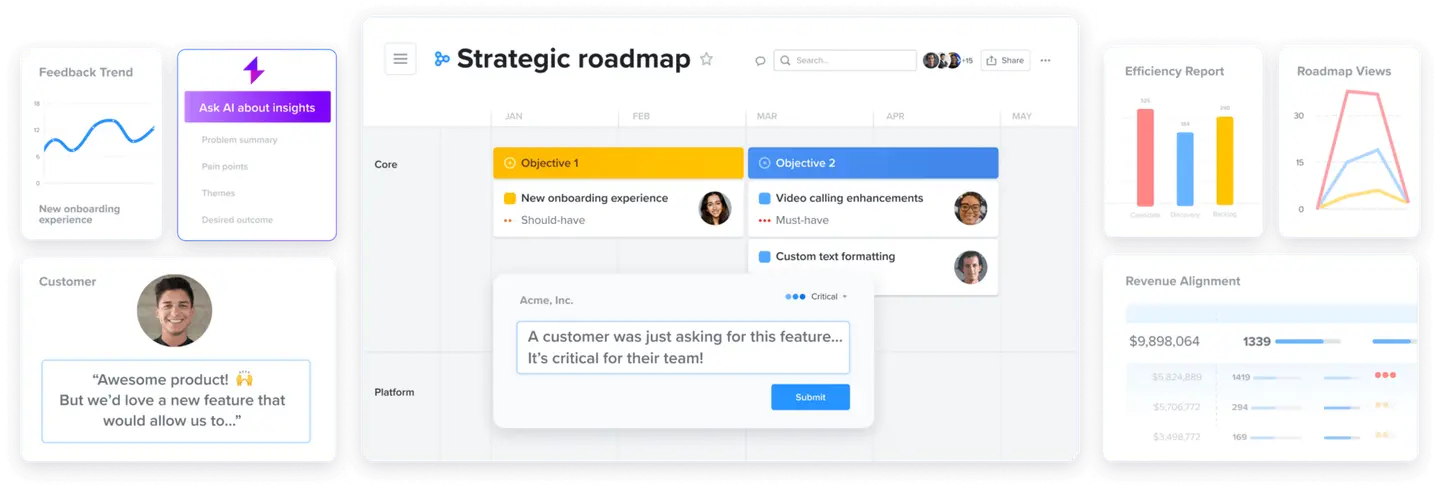
One of the top tools to use for roadmaps is called ProductBoard. This tool helps product teams focus on what users really want. It brings together customer feedback, helps choose the right features to work on, and makes it easy for the product team to stay on the same page.
ProductBoard is built to support product teams in truly understanding what their customers need and deciding what to build next. It offers helpful features like prioritization frameworks and easy-to-use tools for collecting product feedback. It makes it simple to gather input directly from customers and, by using built-in methods to sort and prioritize that feedback, teams can more effectively manage the product lifecycle and make decisions that are grounded in real user needs.
While ProductBoard is a great tool overall, it may not offer integrations with some of the more specialized software development or research tools. As a result, users might need to turn to other solutions to handle specific tasks. There are other platforms that offer similar functionality to Productboard for roadmapping, including LaunchNotes, Aha!, ProductPlan, and Tempo Roadmaps (formally called Roadmunk). Let’s dive into each of these a bit more.
Top ProductBoard Alternatives At a Glance
- Best for organizing product features – LaunchNotes
- Best for a visual roadmap – Aha!
- Best for a flexible roadmap – ProductPlan
- Best for managing client feedback – Tempo Roadmaps
LaunchNotes takes the busywork out of product updates. Paste in your notes or tickets and get a structured announcement draft instantly. It’s designed for teams that want to save time, segment updates, and keep communication consistent across every channel.
LaunchNotes
LaunchNotes is an excellent roadmapping tool designed to improve communication and alignment across product and software teams. It’s effective for both internal teams and external customers, reducing chaos around product updates and releases.
Key Features & Pros
One of LaunchNotes’ standout features is its seamless integration with Jira, allowing real-time updates from development to appear instantly on the roadmap. This makes it easy for leaders and stakeholders to track progress and stay informed at every stage. The platform also allows personalized announcements and collects direct feedback from users, streamlining customer engagement and helping to prioritize what truly matters to the audience.
LaunchNotes offers targeted updates to specific groups and gathers valuable feedback, making it much easier to identify which features are resonating and what needs improvement. Everything is organized in a central place, and the interface is intuitive and user-friendly. Voting is also available for ideas, and can be turned on and off.
Read our full LaunchNotes review here!
Cons
Since LaunchNotes is still a relatively new platform, some integrations, besides Jira, are still being developed and may lack depth compared to other tools. Currently, there’s no way to send communications strictly to internal team members without external users also having access. Additionally, the platform doesn’t offer much email customization yet.
One thing some users find frustrating about LaunchNotes is that it only allows feedback to be added if it’s tied to an existing idea or roadmap item, so users need to take the extra step of creating a roadmap item before they can log feedback. Another improvement many would love to see is support for managing multiple roadmaps, which would make the tool even more flexible for teams with different projects or products.
Pricing
LaunchNotes has two pricing plan options. The Growth plan is a great fit for scale-ups who want to keep their teams and customers in the loop about product updates, feature releases, and future plans. For $249 a month, it includes features such as an embeddable widget, support for two users, one page for sharing roadmaps and announcements, plus customer feedback tools, premium onboarding, priority support, custom SLAs, and integrations.
For larger organizations, the Premium plan is more customizable, supports 10 or more users, offers extra pages, and adds enhanced features with custom pricing. Both plans have a free 14-day trial so you can try everything out before committing.
Summary
What sets LaunchNotes apart is its focus on clear, targeted communication, which ensures both the product team and users always know what’s happening and when. This platform is a favorite for simplifying updates, making feature rollouts smoother, increasing adoption, and ensuring that feedback is always part of the process. If clear communication and organized release management are your priorities, LaunchNotes is well worth a look.
Aha!
Aha! is a top choice for product managers seeking an all-in-one solution for product strategy, roadmapping, and analytics. Its intuitive design makes it simple to create strategies, set up visual timelines, and track progress using roadmaps and Gantt charts. It is especially excellent for managing complex marketing projects, where clarity and structured planning are essential.
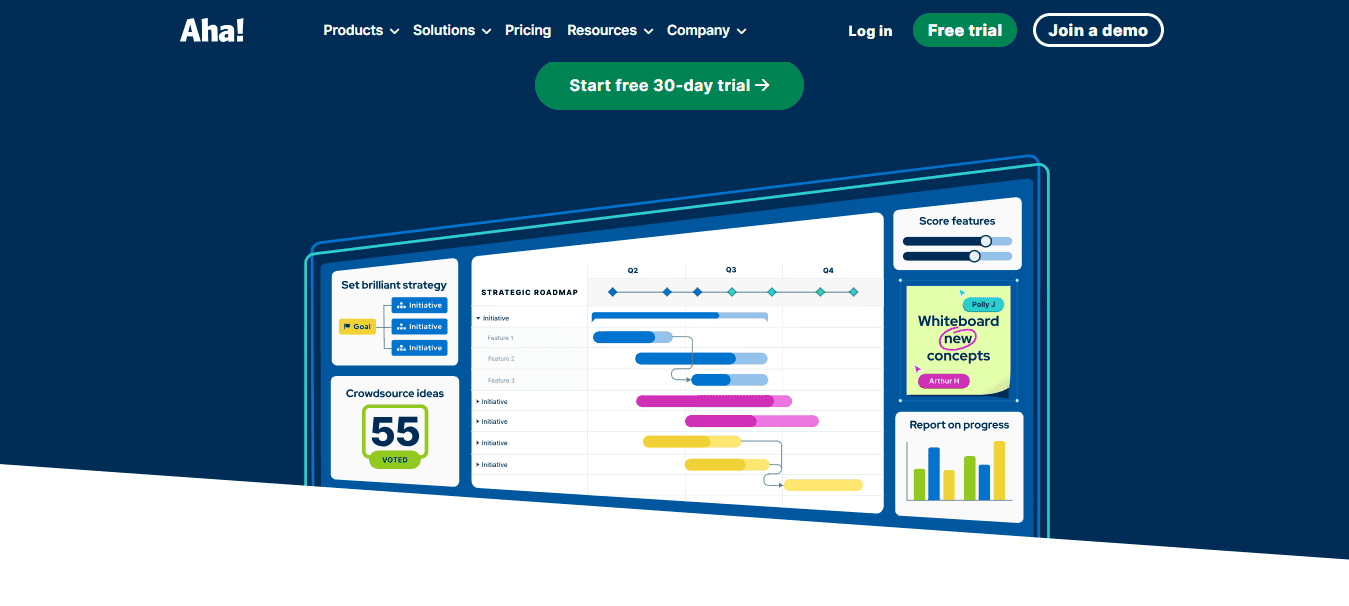
Key Features & Pros
Aha! offers powerful product analytics, giving teams comprehensive insights into trends and performance. Its idea management features are also impressive, making it easy to collect, organize, and prioritize feedback from different stakeholders. There’s a wide selection of templates, which helps standardize processes and saves time. Their customer support team is responsive and helpful, offering valuable guidance during interactions.
Cons
Some users have reported occasional bugs when using certain integrations, and note that the platform doesn’t yet support every type of metric a team might require for comprehensive product tracking and analysis.
Additionally, Aha!’s interface tends to be a bit more complex compared to other product management tools. Because the platform offers such a wide range of powerful features, new users may experience a steep learning curve as they become familiar with its extensive capabilities.
Pricing
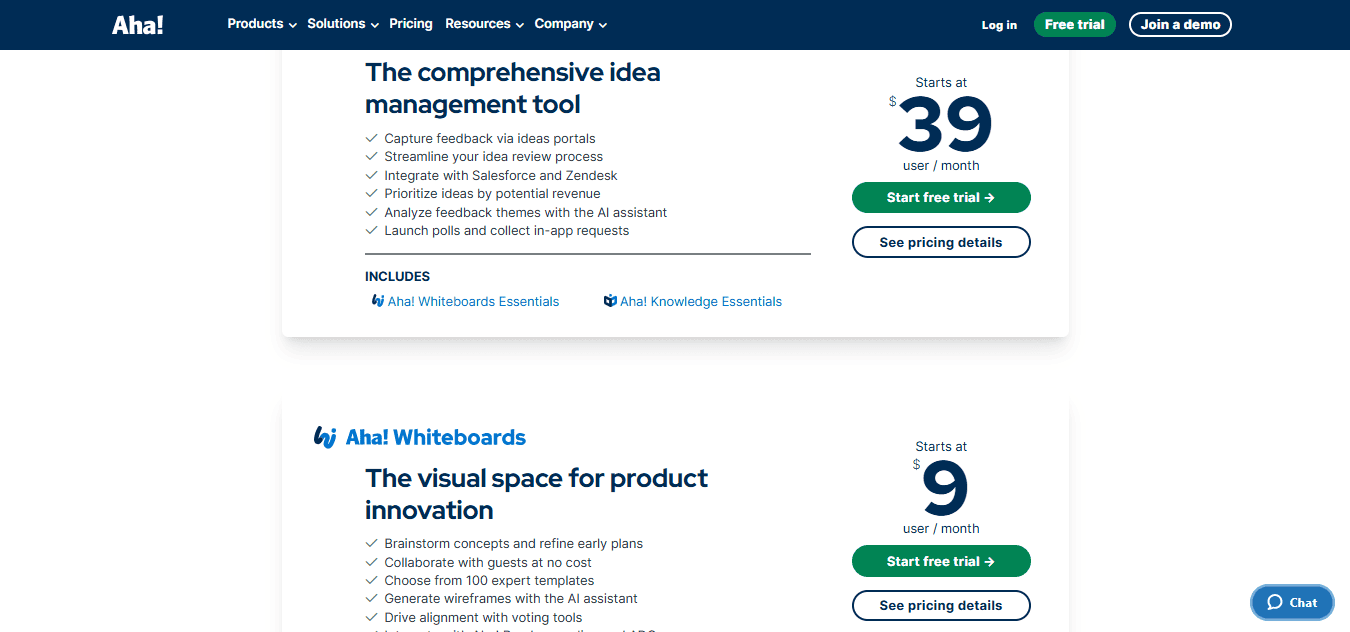
Aha! provides various product-specific plans: Roadmaps, Discovery, Ideas, Whiteboards, Knowledge, Teamwork, and Develop. The Roadmaps complete solution starts at $59 per user per month and includes essentials like idea portals, virtual whiteboards, knowledge base, advanced integrations, and AI-powered features. For teams focused on just customer research or idea management, both Discovery and Ideas start at $39 per user per month and offer unlimited interviews or advanced feedback tools.
Visual collaboration is available with Whiteboards from $9 per user per month, while Knowledge for centralized documentation starts at $18 per user per month. For project and agile management, Teamwork and Develop are each available from $9 per user per month. All products come with a free trial, allowing teams to explore the features before committing.
Summary
Aha! is an excellent platform for product and marketing teams, enabling easy organization of ideas, clear visual tracking, and effective feedback management, all enhanced by robust templates and analytics.

ProductPlan
ProductPlan is a flexible product management roadmapping solution that makes it simple to build and adapt product workflows, prioritize ideas, and create visual roadmaps for more efficient product launches. A key benefit is its ability to link product roadmaps with OKR goals, giving executives a clear view of how product strategy aligns with broader organizational objectives. However, ProductPlan’s limited integrations mean it might not sync seamlessly with every tool your team uses, which can complicate workflows.
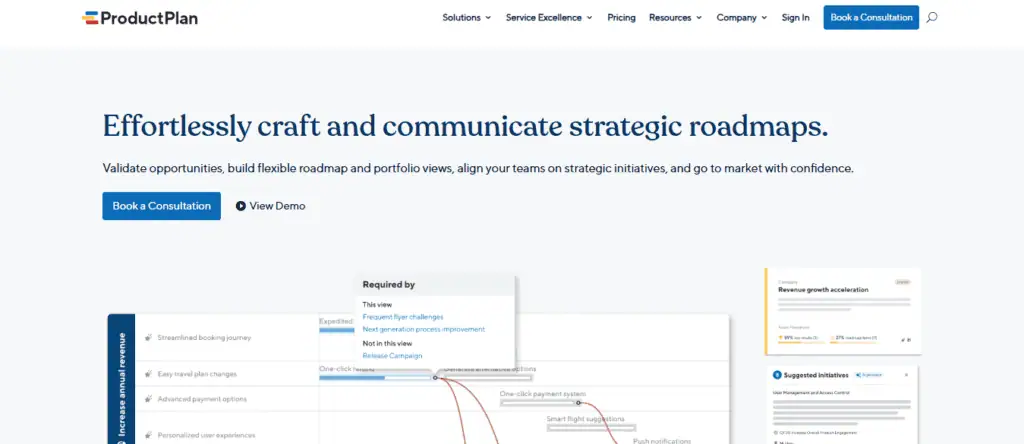
Key Features & Pros
ProductPlan stands out for its ease of setting up roadmaps and sharing clear visual progress with stakeholders. Features like the intuitive drag-and-drop interface, built-in templates, and clear milestone and timeline visualizations make it very user-friendly.
Cons
The tool does not include its own dedicated backlog management system, which means that teams often need to rely on additional software to effectively handle and prioritize their backlogs.
Additionally, the analytics features offered are relatively basic, making it difficult for teams to gain more advanced or in-depth, data-driven insights from their product data. This can be a limitation for organizations looking for robust analytics and comprehensive backlog management all in one platform.
Pricing
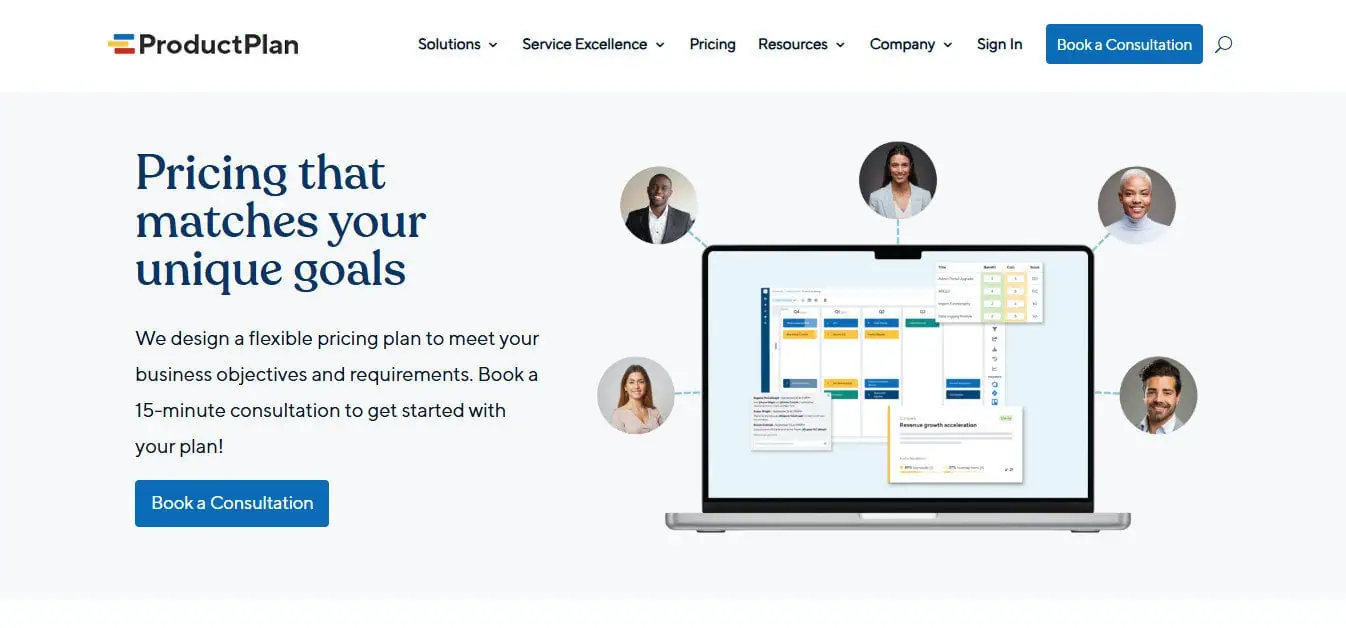
ProductPlan offers a range of plans to fit growing teams, starting with a free Starter plan that allows for collecting feedback and organizing priorities. As needs expand, upgrade to the Essentials at $19 per month or Pro plan at $59 per month for more powerful features like release planning, deeper insights, and increased customization to help you align the product team and drive results. For larger organizations looking for advanced controls and security, the Enterprise plan includes strategic planning tools, enhanced integrations, and custom support
Summary
ProductPlan is quick to set up and easy to use, supporting unlimited roadmaps which are ideal for teams managing multiple strategic initiatives. Its combination of user-friendly templates and clear milestone tracking makes it a strong choice for teams eager to jump right into product planning.

Tempo Roadmaps
Tempo is a product management tool, formally called Roadmunk, that really makes it easy for teams to build, visualize, and clearly communicate their strategic plans across the company. It’s designed to help everyone work together efficiently and stay aligned, so sharing your roadmap in high-stakes meetings like executive or boardroom presentations is a breeze. That way, everyone stays in the loop and knows what’s coming next.
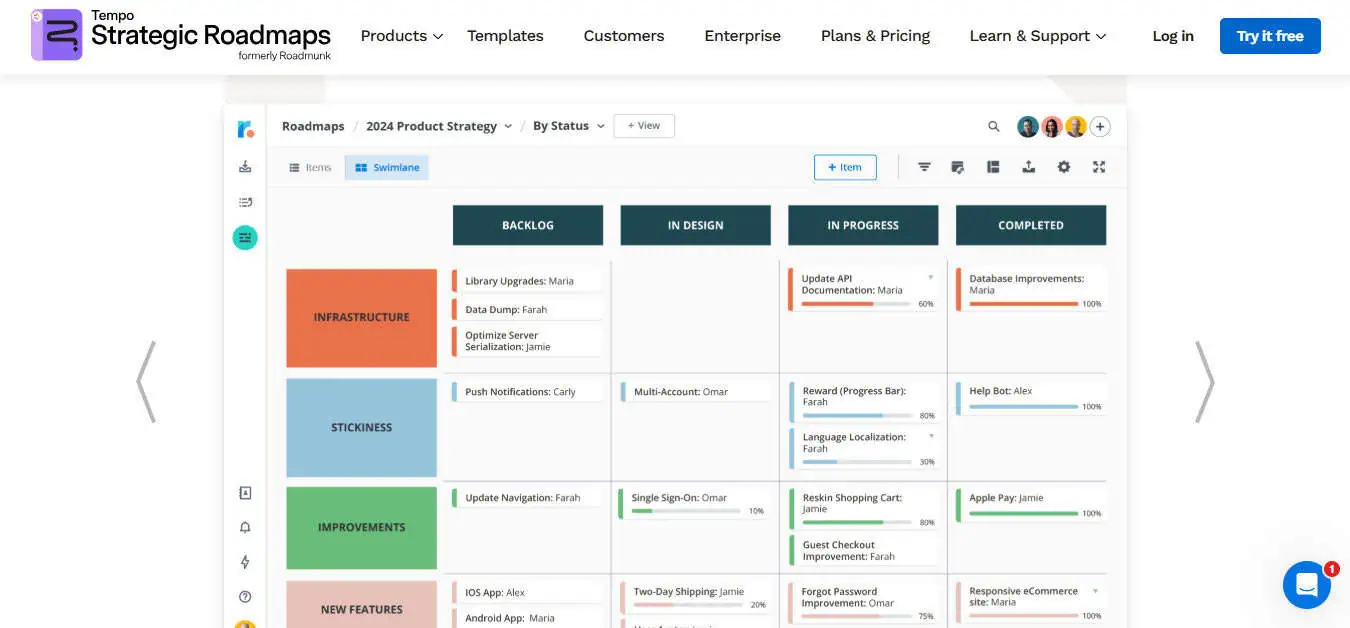
Key Features & Pros
One feature that really stands out is the Feedback Inbox. It’s like a one-stop shop for all your user feedback. You can keep everything in one organized place, whether it’s coming from emails, Salesforce or another CRM, support chats, or even straight from your browser using their handy Chrome extension. This means it’s super simple for anyone on your team to gather valuable insights and share them directly with your product team without feedback slipping through the cracks.
But Tempo doesn’t just collect feedback; it actually helps turn real user suggestions and problems into actionable product ideas. The platform has helpful prioritization options using straightforward templates like Value vs. Effort or R.I.C.E. (which stands for Reach, Impact, Confidence, and Effort), or even set up a scoring system that fits the team’s priorities. This makes it a lot easier to figure out which features will make the biggest difference for users, so product teams can focus on what really matters.
Cons
Tempo integrations are somewhat limited compared to other platforms, especially with project management software platforms. While the software does offer a lot of customization options, the number of settings and configurations can make it feel a bit overwhelming at first. The platform currently lacks step-by-step tutorials, which makes onboarding more challenging for new users. Additionally, the user experience could be simplified to help reduce the learning curve and make it easier for beginners to get started.
Pricing
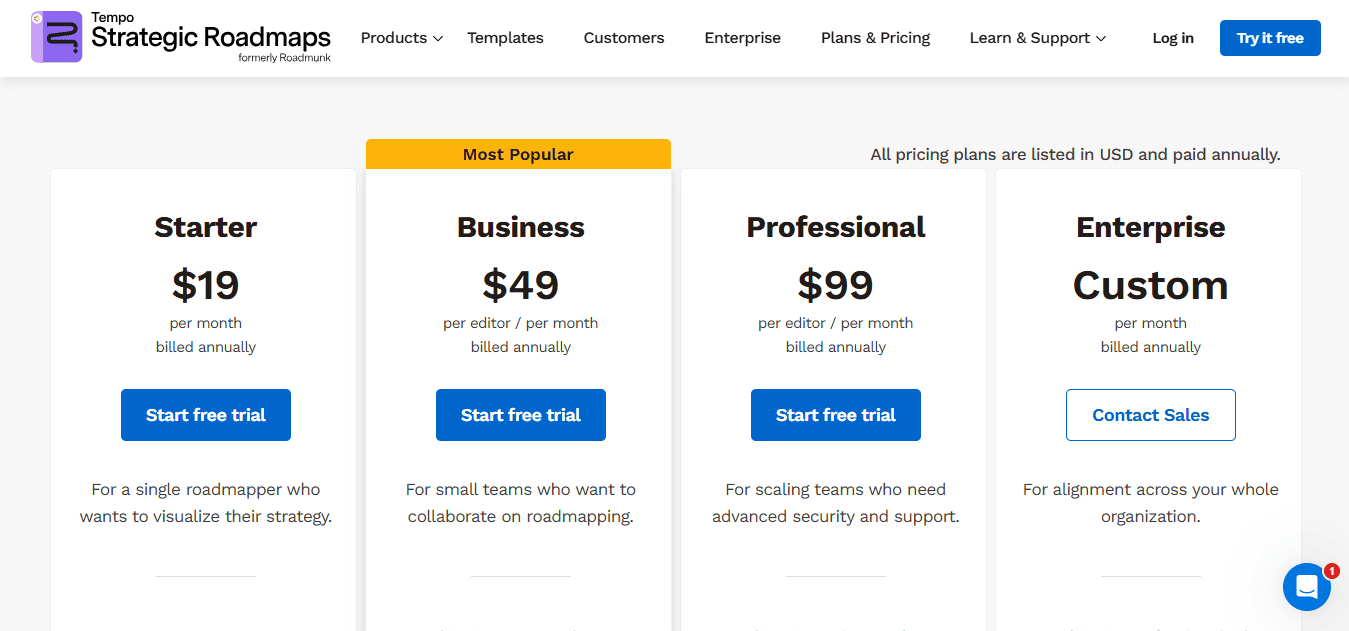
All Tempo plans start with a free 14-day trial. The Starter plan is $19 per month and is great for single users wanting unlimited roadmaps and feedback collection. The Business plan, at $49 per editor per month, adds collaborative features for small teams, including customizations and portfolio roadmaps, with optional two-way Jira and Azure DevOps sync.
For growing teams that need extra security and support, the Professional plan is $99 per editor per month and offers SSO integration and more reviewer seats. Enterprise plans offer custom pricing and come with advanced customization and private cloud options for larger organizations.
Summary
Tempo features a clean, user-friendly interface that makes it easy for teams to create and manage roadmaps. It’s an excellent tool for product managers and teams to visualize, communicate, and effectively manage their product development strategies.

Which roadmap tool is best?
The short answer is: it depends!
Having an organized and visible product roadmap is essential for keeping the product team on track and customers informed. If your current system feels cluttered or difficult to manage, it might be time to try a dedicated roadmapping tool, and which one to pick depends on what is best suited for your company. All of these tools make planning easier, improve communication, and help everyone stay aligned and moving toward the same goals.
Among the top roadmapping tools, ProductBoard excels at turning user feedback into actionable plans and helping teams prioritize what truly matters. While it’s strong on feedback collection and prioritization, it can feel overwhelming for beginners and has limited integrations. There are many other tools to choose from.
LaunchNotes shines for release management and targeted communication. Aha! is great for visual strategy and complex analytics. ProductPlan offers easy, flexible roadmap creation, and Tempo Roadmaps impresses with its user-friendly interface and feedback organization. Each tool has unique strengths…whether you need deep integration, flexible visuals, advanced analytics, or a streamlined way to turn feedback into features, there’s a solution out there to suit your product team’s needs.
LaunchNotes takes the busywork out of product updates. Paste in your notes or tickets and get a structured announcement draft instantly. It’s designed for teams that want to save time, segment updates, and keep communication consistent across every channel.


